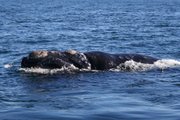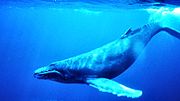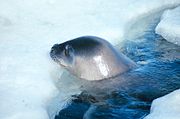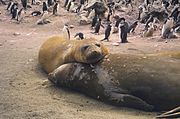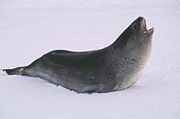- Mammals of Antarctica
-
This is a list of the mammal species recorded in Antarctica. There are 17 mammal species in Antarctica, all of which are marine mammals. Three of these species are considered to be endangered, and four are listed as data deficient.[1]
The following tags are used to highlight each species' conservation status as assessed by the IUCN:
EX Extinct No reasonable doubt that the last individual has died. EW Extinct in the Wild Known only to survive in captivity or as a naturalized population well outside its historic range. CR Critically Endangered The species is facing an extremely high risk of extinction in the wild. EN Endangered The species is facing a very high risk of extinction in the wild. VU Vulnerable The species is facing a high risk of extinction in the wild. NT Near Threatened The species does not currently qualify as being at high risk of extinction but it is likely to do so in the future. LC Least Concern The species is not currently at risk of extinction in the wild. DD Data Deficient There is inadequate information to assess the risk of extinction for this species. Contents
Subclass: Theria
Infraclass: Eutheria
Order: Cetacea (whales)
The order Cetacea includes whales, dolphins and porpoises. They are the mammals most fully adapted to aquatic life with a spindle-shaped nearly hairless body, protected by a thick layer of blubber, and forelimbs and tail modified to provide propulsion underwater.
- Suborder: Mysticeti
- Family: Balaenidae
- Genus: Eubalaena
- Southern Right Whale Eubalaena australis LC
- Genus: Eubalaena
- Family: Balaenopteridae
- Subfamily: Balaenopterinae
- Genus: Balaenoptera
- Minke Whale Balaenoptera acutorostrata LC
- Sei whale Balaenoptera borealis EN
- Fin Whale Balaenoptera physalus EN
- Blue Whale Balaenoptera musculus EN
- Genus: Balaenoptera
- Subfamily: Megapterinae
- Genus: Megaptera
- Humpback Whale Megaptera novaeangliae LC
- Genus: Megaptera
- Subfamily: Balaenopterinae
- Family: Balaenidae
- Suborder: Odontoceti
- Superfamily: Platanistoidea
- Family: Phocoenidae
- Genus: Phocoena
- Spectacled Porpoise Phocoena dioptrica DD
- Genus: Phocoena
- Family: Ziphidae
- Genus: Berardius
- Giant beaked whale Berardius arnuxii DD
- Subfamily: Hyperoodontidae
- Genus: Hyperoodon
- Bottlenose whale Hyperoodon planifrons LC
- Genus: Hyperoodon
- Genus: Berardius
- Family: Delphinidae (marine dolphins)
- Genus: Cephalorhynchus
- Commerson's Dolphin Cephalorhynchus commersonii DD
- Genus: Lagenorhynchus
- Hourglass Dolphin Lagenorhynchus cruciger LC
- Genus: Orcinus
- Orca Orcinus orca DD
- Genus: Cephalorhynchus
- Family: Phocoenidae
- Superfamily: Platanistoidea
Order: Carnivora (carnivorans)
There are over 260 species of carnivorans, the majority of which feed primarily on meat. They have a characteristic skull shape and dentition.
- Suborder: Caniformia
- Family: Phocidae (earless seals)
- Genus: Hydrurga
- Leopard Seal Hydrurga leptonyx LC
- Genus: Leptonychotes
- Weddell Seal Leptonychotes weddellii LC
- Genus: Lobodon
- Crabeater Seal Lobodon carcinophaga LC
- Genus: Mirounga
- Southern Elephant Seal Mirounga leonina LC
- Genus: Ommatophoca
- Ross Seal Ommatophoca rossii LC
- Genus: Hydrurga
- Family: Phocidae (earless seals)
See also
- List of chordate orders
- Lists of mammals by region
- List of prehistoric mammals
- Mammal classification
- New mammal species
Notes
- ^ This list is derived from the IUCN Red List which lists species of mammals and includes those mammals that have recently been classified as extinct (since 1500 AD). The taxonomy and naming of the individual species is based on those used in existing Wikipedia articles as of 21 May 2007 and supplemented by the common names and taxonomy from the IUCN, Smithsonian Institute, or University of Michigan where no Wikipedia article was available.
References
- "The IUCN Red List of Threatened Species: Mammals of Antarctica". IUCN. 2001. http://www.iucnredlist.org/search/search.php?kingname=ANIMALIA&phyname=CHORDATA&claname=MAMMALIA&freetext=&modifier=phrase&criteria=wholedb&taxa_species=1&redlistCategory%5B0%5D=all&redlistAssessyear%5B0%5D=all&country%5B0%5D=AQ&aquatic%5B0%5D=all®ions%5B0%5D=all&habitats%5B0%5D=all&threats%5B0%5D=all&Submit_x=34&Submit_y=9&extendedResults=0&terrestrial=0&marine=0&freshwater=0&offset=0&sortorder%5B0%5D=spcscientificname&sortorder%5B1%5D=genname&sortorder%5B2%5D=spcname&sortorder%5B3%5D=spcauthor&sortorder%5B4%5D=spcinfrarank&sortorder%5B5%5D=spcinfraepithet&sortorder%5B6%5D=spcinfrarankauthor&sortorder%5B7%5D=spcstockname&sortorder%5B8%5D=comname_comp&sortorder%5B9%5D=rlcabb&sortorder%5B10%5D=rlscriteria&sortorder%5B11%5D=poptrend_code&sortorder%5B12%5D=rlcatcrit2001&sortorder%5B13%5D=spcrecid&sortorder%5B14%5D=kingname&debug=0&taxa_subspc=0&taxa_stock=0&newsort=Genus. Retrieved 22 May 2007.[dead link]
- "Mammal Species of the World". Smithsonian National Museum of Natural History. 2005. Archived from the original on 27 April 2007. http://web.archive.org/web/20070427043030/http://nmnhgoph.si.edu/msw/. Retrieved 22 May 2007.
- "Animal Diversity Web". University of Michigan Museum of Zoology. 1995-2006. http://animaldiversity.ummz.umich.edu/site/index.html. Retrieved 22 May 2007.
Categories:- Lists of mammals by location
- Fauna of Antarctica
- Antarctica-related lists
- Suborder: Mysticeti
Wikimedia Foundation. 2010.

